Novel Magnetically-Recoverable Solid Acid Catalysts with a Hydrophobic Layer in Protecting the Active Sites from Water Poisoning
Abstract
:1. Introduction
2. Chemicals and Methods
2.1. Chemicals and Characterizations
2.2. Preparation of Catalysts
2.2.1. Fe3O4@SiO2 Supports
2.2.2. Hydrophilic Catalyst Fe3O4@SiO2-PrSO3H
2.2.3. Hydrophobic Catalysts Fe3O4@SiO2-Oc&PrSO3H and Fe3O4@SiO2-Me&PrSO3H
2.3. EAC Synthesis
3. Results and Discussion
3.1. Catalysts’ Hydrophilic and Hydrophobic Test
3.2. Catalyst Characterization
3.2.1. FT-IR
3.2.2. EDS
3.2.3. XRD
3.2.4. VSM
3.2.5. SEM
3.3. The Impact of the Molar Ratio of EtOH and HOAc on the Conversion Rate of HOAc
3.4. The Influence of the Amount of Catalyst on Reaction
3.5. The Effect of Reaction Time on the Conversion Rate of HOAc
3.6. Effect of Catalysts’ Hydrophobicity on the Conversion Rate of HOAc and Reaction Rate
3.7. The Influence of Water Content on Catalysts’ Stability
3.8. Reusability Test
3.9. Comparison with Other Studies
4. Conclusions
Author Contributions
Funding
Institutional Review Board Statement
Informed Consent Statement
Data Availability Statement
Conflicts of Interest
References
- Rai, A.; Bhaskar, S.; Ganesh, K.M.; Ramamurthy, S.S. Cellphone-based attomolar tyrosine sensing based on Kollidon-mediated bimetallic nanorod in plasmon-coupled directional and polarized emission architecture. Mater. Chem. Phys. 2022, 285, 126129. [Google Scholar] [CrossRef]
- Rai, A.; Bhaskar, S.; Reddy, N.; Ramamurthy, S.S. Cellphone-Aided Attomolar Zinc Ion Detection Using Silkworm Protein-Based Nanointerface Engineering in a Plasmon-Coupled Dequenched Emission Platform. ACS Sustain. Chem. Eng. 2021, 9, 14959–14974. [Google Scholar] [CrossRef]
- Xu, X.; Geng, A.; Yang, C.; Carabineiro, S.A.C.; Lv, K.; Zhu, J.; Zhao, Z. One-pot synthesis of La–Fe–O@CN composites as photo-Fenton catalysts for highly efficient removal of organic dyes in wastewater. Ceram. Int. 2020, 46, 10740–10747. [Google Scholar] [CrossRef]
- Zhang, C.; Yan, S.; Lin, J.; Hu, Q.; Zhong, J.; Zhang, B.; Cheng, Z. Electrochemical Reduction of CO2 to CO on Hydrophobic Zn Foam Rod in a Microchannel Electrochemical Reactor. Processes 2021, 9, 1592. [Google Scholar] [CrossRef]
- Shi, J.; Zhang, L.; Cheng, Z. Design of Water-Tolerant Solid Acids: A Trade-Off Between Hydrophobicity and Acid Strength and their Catalytic Performance in Esterification. Catal. Surv. Asia 2021, 25, 279–300. [Google Scholar] [CrossRef]
- Xu, Z.; Zhao, G.; Hedin, N.; Xu, M.; Liu, J.; Ullah, L.; Zhang, S. Fast Catalytic Esterification Using a Hydrophobized Zr-MOF with Acidic Ionic Liquid Linkers. Chemistryselect 2020, 5, 1153–1156. [Google Scholar] [CrossRef]
- Shu, Q.; Liu, X.; Huo, Y.; Tan, Y.; Zhang, C.; Zou, L. Construction of a Brönsted-Lewis solid acid catalyst La-PW-SiO2/SWCNTs based on electron withdrawing effect of La(III) on π bond of SWCNTs for biodiesel synthesis from esterification of oleic acid and methanol. Chin. J. Chem. Eng. 2022, 44, 351–362. [Google Scholar] [CrossRef]
- Durai, M.; Kumaravel, S.; Mukannan, A.; Krishnakumar, B.; Thiripuranthagan, S.; Ahn, Y.H. Esterification of valeric acid over PTA supported mesoporous Al-SBA-15 as efficient solid acid catalysts. J. Porous Mater. 2021, 28, 1907–1917. [Google Scholar] [CrossRef]
- Liu, F.; Huang, K.; Zheng, A.; Xiao, F.-S.; Dai, S. Hydrophobic Solid Acids and Their Catalytic Applications in Green and Sustainable Chemistry. ACS Catal. 2018, 8, 372–391. [Google Scholar] [CrossRef]
- Okuhara, T. Water-tolerant solid acid catalysts. Chem. Rev. 2002, 102, 3641–3666. [Google Scholar] [CrossRef]
- Corma, A.; Garcia, H. Lewis acids: From conventional homogeneous to green homogeneous and heterogeneous catalysis. Chem. Rev. 2003, 103, 4307–4365. [Google Scholar] [CrossRef] [PubMed]
- Zheng, A.; Liu, S.B.; Deng, F. 31P NMR Chemical Shifts of Phosphorus Probes as Reliable and Practical Acidity. Chem. Rev. 2017, 117, 12475–12531. [Google Scholar] [CrossRef] [PubMed]
- Choi, M.; Na, K.; Kim, J.; Sakamoto, Y.; Terasaki, O.; Ryoo, R. Stable single-unit-cell nanosheets of zeolite MFI as active and long-lived catalysts. Nature 2009, 461, 246–249. [Google Scholar] [CrossRef] [PubMed]
- Suganuma, S.; Nakajima, K.; Kitano, M.; Yamaguchi, D.; Kato, H.; Hayashi, S.; Hara, M. Hydrolysis of Cellulose by Amorphous Carbon Bearing SO3H, COOH, and OH Groups. J. Am. Chem. Soc. 2008, 130, 12787–12793. [Google Scholar] [CrossRef]
- Zheng, A.; Li, S.; Liu, S.-B.; Deng, F. Acidic Properties and Structure–Activity Correlations of Solid Acid Catalysts Revealed by Solid-State NMR Spectroscopy. Acc. Chem. Res. 2016, 49, 655–663. [Google Scholar] [CrossRef]
- Şimşek, V.; Şahin, S. Characterization and catalytic performance evaluation of a novel heterogeneous mesoporous catalyst for methanol–acetic acid esterification. J. Porous Mater. 2019, 26, 1657–1665. [Google Scholar] [CrossRef]
- Liu, F.; Yi, X.; Chen, W.; Liu, Z.; Chen, W.; Qi, C.-Z.; Song, Y.-F.; Zheng, A. Developing two-dimensional solid superacids with enhanced mass transport, extremely high acid strength and superior catalytic performance. Chem. Sci. 2019, 10, 5875–5883. [Google Scholar] [CrossRef]
- Polshettiwar, V.; Luque, R.; Fihri, A.; Zhu, H.; Bouhrara, M.; Basset, J.M. Magnetically recoverable nanocatalysts. Chem. Rev. 2011, 111, 3036–3075. [Google Scholar] [CrossRef]
- Zheng, X.; Zhang, L.; Li, J.; Luo, S.; Cheng, J.-P. Magnetic nanoparticle supported polyoxometalates (POMs) via non-covalent interaction: Reusable acid catalysts and catalyst supports for chiral amines. Chem. Commun. 2011, 47, 12325–12327. [Google Scholar] [CrossRef]
- Zuo, B.; Li, W.; Wu, X.; Wang, S.; Deng, Q.; Huang, M. Recent Advances in the Synthesis, Surface Modifications and Applications of Core-Shell Magnetic Mesoporous Silica Nanospheres. Chem. Asian. J. 2020, 15, 1248–1265. [Google Scholar] [CrossRef]
- Hubetska, T.; Kobylinska, N.; Menendez, J. Application of Hydrophobic Magnetic Nanoparticles as Cleanup Adsorbents for Pesticide Residue Analysis in Fruit, Vegetable, and Various Soil Samples. J. Agric. Food Chem. 2020, 68, 13550–13561. [Google Scholar] [CrossRef]
- Cardoso, V.F.; Francesko, A.; Ribeiro, C.; Bañobre-López, M.; Martins, P.; Lanceros-Mendez, S. Advances in Magnetic Nanoparticles for Biomedical Applications. Adv. Healthc. Mater. 2018, 7, 1700845. [Google Scholar] [CrossRef] [PubMed]
- Bhaskar, S.; Rai, A.; Kalathur Mohan, G.; Ramamurthy, S.S. Mobile Phone Camera-Based Detection of Surface Plasmon-Coupled Fluorescence from Streptavidin Magnetic Nanoparticles and Graphene Oxide Hybrid Nanointerface. ECS Trans. 2022, 107, 3223–3232. [Google Scholar] [CrossRef]
- Li, S.; Wang, W.; Zhao, J. Magnetic-heteropolyacid mesoporous catalysts for deep oxidative desulfurization of fuel: The influence on the amount of APES used. J. Colloid Interface Sci. 2020, 571, 337–347. [Google Scholar] [CrossRef] [PubMed]
- Zhang, Q.; Su, H.; Luo, J.; Wei, Y. A magnetic nanoparticle supported dual acidic ionic liquid: A “quasi-homogeneous” catalyst for the one-pot synthesis of benzoxanthenes. Green Chem. 2012, 14, 201–208. [Google Scholar] [CrossRef]
- Shylesh, S.; Schünemann, V.; Thiel, W.R. Magnetically Separable Nanocatalysts: Bridges between Homogeneous and Heterogeneous Catalysis. Angew. Chem. Int. Ed. 2010, 49, 3428–3459. [Google Scholar] [CrossRef] [PubMed]
- Tartaj, P.; Serna, C.J. Synthesis of Monodisperse Superparamagnetic Fe/Silica Nanospherical Composites. J. Am. Chem. Soc. 2003, 125, 15754–15755. [Google Scholar] [CrossRef]
- Graf, C.; Vossen, D.L.J.; Imhof, A.; van Blaaderen, A. A General Method To Coat Colloidal Particles with Silica. Langmuir 2003, 19, 6693–6700. [Google Scholar] [CrossRef]
- El-Toni, A.M.; Habila, M.A.; Labis, J.P.; Alothman, Z.A.; Alhoshan, M.; Elzatahry, A.A.; Zhang, F. Design, synthesis and applications of core–shell, hollow core, and nanorattle multifunctional nanostructures. Nanoscale 2016, 8, 2510–2531. [Google Scholar] [CrossRef]
- Lu, A.H.; Salabas, E.L.; Schüth, F. Magnetic nanoparticles: Synthesis, protection, functionalization, and application. Angew. Chem. Int. Ed. 2007, 46, 1222–1244. [Google Scholar] [CrossRef] [PubMed]
- Wu, Z.; Li, Z.; Wu, G.; Wang, L.; Lu, S.; Wang, L.; Wan, H.; Guan, G.J.I.; Research, E.C. Brønsted Acidic Ionic Liquid Modified Magnetic Nanoparticle: An Efficient and Green Catalyst for Biodiesel Production. Ind. Eng. Chem. Res. 2014, 53, 3040–3046. [Google Scholar] [CrossRef]
- Zhang, H.; Li, H.; Pan, H.; Wang, A.; Souzanchi, S.; Xu, C.; Yang, S. Magnetically recyclable acidic polymeric ionic liquids decorated with hydrophobic regulators as highly efficient and stable catalysts for biodiesel production. Appl. Energy 2018, 223, 416–429. [Google Scholar] [CrossRef]
- Xie, W.; Wang, H. Immobilized polymeric sulfonated ionic liquid on core-shell structured Fe3O4/SiO2 composites: A magnetically recyclable catalyst for simultaneous transesterification and esterifications of low-cost oils to biodiesel. Renew. Energy 2020, 145, 1709–1719. [Google Scholar] [CrossRef]
- Escobar, A.M.; Blanco, M.N.; Martínez, J.J.; Cubillos, J.A.; Romanelli, G.P.; Pizzio, L.R. Biomass Derivative Valorization Using Nano Core-Shell Magnetic Materials Based on Keggin-Heteropolyacids: Levulinic Acid Esterification Kinetic Study with N-Butanol. J. Nanomater. 2019, 2019, 5710708. [Google Scholar] [CrossRef]
- Abida, K.; Chudasama, B.; Ali, A. Development and functionalization of magnetic nanoparticles as stable and reusable catalysts for triacetin synthesis. New J. Chem. 2020, 44, 9365–9376. [Google Scholar] [CrossRef]
- Nuryono, N.; Qomariyah, A.; Kim, W.; Otomo, R.; Rusdiarso, B.; Kamiya, Y. Octyl and propylsulfonic acid co-fixed Fe3O4@SiO2 as a magnetically separable, highly active and reusable solid acid catalyst in water. Mol. Catal. 2019, 475, 110248. [Google Scholar] [CrossRef]
- Esfahani, F.K.; Zareyee, D.; Yousefi, R. Sulfonated Core-Shell Magnetic Nanoparticle (Fe3O4@SiO2@PrSO3H) as a Highly Active and Durable Protonic Acid Catalyst; Synthesis of Coumarin Derivatives through Pechmann Reaction. ChemCatChem 2014, 6, 3333–3337. [Google Scholar] [CrossRef]
- Mobaraki, A.; Movassagh, B.; Karimi, B. Hydrophobicity-enhanced magnetic solid sulfonic acid: A simple approach to improve the mass transfer of reaction partners on the surface of the heterogeneous catalyst in water-generating reactions. Appl. Catal. A Gen. 2014, 472, 123–133. [Google Scholar] [CrossRef]
- Liu, F.; Kong, W.; Qi, C.; Zhu, L.; Xiao, F.-S. Design and Synthesis of Mesoporous Polymer-Based Solid Acid Catalysts with Excellent Hydrophobicity and Extraordinary Catalytic Activity. ACS Catal. 2012, 2, 565–572. [Google Scholar] [CrossRef]
- Long, W.; Jones, C. Hybrid Sulfonic Acid Catalysts Based on Silica-Supported Poly(Styrene Sulfonic Acid) Brush Materials and Their Application in Ester Hydrolysis. ACS Catal. 2011, 1, 674–681. [Google Scholar] [CrossRef]
- Tsai, C.-H.; Chen, H.-T.; Althaus, S.M.; Mao, K.; Kobayashi, T.; Pruski, M.; Lin, V.S.Y. Rational Catalyst Design: A Multifunctional Mesoporous Silica Catalyst for Shifting the Reaction Equilibrium by Removal of Byproduct. ACS Catal. 2011, 1, 729–732. [Google Scholar] [CrossRef]
- Duan, X.; Liu, Y.; Zhao, Q.; Wang, X.; Li, S. Water-tolerant heteropolyacid on magnetic nanoparticles as efficient catalysts for esterification of free fatty acid. RSC Adv. 2013, 3, 13748–13755. [Google Scholar] [CrossRef]
- Zolfagharinia, S.; Kolvari, E.; Koukabi, N. A New Type of Magnetically-Recoverable Heteropolyacid Nanocatalyst Supported on Zirconia-Encapsulated Fe3O4 Nanoparticles as a Stable and Strong Solid Acid for Multicomponent Reactions. Catal. Lett. 2017, 147, 1551–1566. [Google Scholar] [CrossRef]
- Kuzminska, M.; Carlier, N.; Backov, R.; Gaigneaux, E.M. Magnetic nanoparticles: Improving chemical stability via silica coating and organic grafting with silanes for acidic media catalytic reactions. Appl. Catal. A Gen. 2015, 505, 200–212. [Google Scholar] [CrossRef]
- Li, J.; Zhao, H.; Hou, X.; Fa, W.; Cai, J. Fe3O4@SiO2-SO3H nanocomposites: An efficient magnetically separable solid acid catalysts for esterification reaction. Micro Nano Lett. 2017, 12, 53–57. [Google Scholar] [CrossRef]
- Wang, C.; Tao, S.; Wei, W.; Meng, C.; Liu, F.; Han, M. Multifunctional mesoporous material for detection, adsorption and removal of Hg2+ in aqueous solution. J. Mater. Chem. 2010, 20, 4635–4641. [Google Scholar] [CrossRef]
- Ghasemzadeh, M.A.; Abdollahi-Basir, M.H.; Babaei, M. Fe3O4@SiO2–NH2 core-shell nanocomposite as an efficient and green catalyst for the multi-component synthesis of highly substituted chromeno[2,3-b]pyridines in aqueous ethanol media. Green Chem. Lett. Rev. 2015, 8, 40–49. [Google Scholar] [CrossRef]
- Sharma, P.; Vyas, S.; Patel, A. Heteropolyacid supported onto neutral alumina: Characterization and esterification of 1° and 2° alcohol. J. Mol. Catal. A Chem. 2004, 214, 281–286. [Google Scholar] [CrossRef]
- Liu, F.; Wang, L.; Sun, Q.; Zhu, L.; Meng, X.; Xiao, F.-S. Transesterification Catalyzed by Ionic Liquids on Superhydrophobic Mesoporous Polymers: Heterogeneous Catalysts That Are Faster than Homogeneous Catalysts. J. Am. Chem. Soc. 2012, 134, 16948–16950. [Google Scholar] [CrossRef]
- Manayil, J.C.; dos Santos, V.C.; Jentoft, F.C.; Granollers Mesa, M.; Lee, A.F.; Wilson, K. Octyl Co-grafted PrSO3H/SBA-15: Tunable Hydrophobic Solid Acid Catalysts for Acetic Acid Esterification. ChemCatChem 2017, 9, 2231–2238. [Google Scholar] [CrossRef] [Green Version]
- Dacquin, J.-P.; Cross, H.E.; Brown, D.R.; Düren, T.; Williams, J.J.; Lee, A.F.; Wilson, K. Interdependent lateral interactions, hydrophobicity and acid strength and their influence on the catalytic activity of nanoporous sulfonic acid silicas. Green Chem. 2010, 12, 1383–1391. [Google Scholar] [CrossRef]
- Mekala, M.; Goli, V.R. Kinetics of esterification of methanol and acetic acid with mineral homogeneous acid catalyst. Chin. J. Chem. Eng. 2015, 23, 100–105. [Google Scholar] [CrossRef]
- Rönnback, R.; Salmi, T.; Vuori, A.; Haario, H.; Lehtonen, J.; Sundqvist, A.; Tirronen, E. Development of a kinetic model for the esterification of acetic acid with methanol in the presence of a homogeneous acid catalyst. Chem. Eng. Sci. 1997, 52, 3369–3381. [Google Scholar] [CrossRef]
- He, R.; Zou, Y.; Muhammad, Y.; Tong, Z. Study on the Intensification of Reaction Kinetics and Reactive Distillation for the Esterification of N-Butyl Acetate Using [HSO3-BMIM][HSO4] as a High-Efficiency Ionic Liquid Catalyst. Ind. Eng. Chem. Res. 2021, 60, 12847–12863. [Google Scholar] [CrossRef]
- Lee, S.-G.; Park, J.H. Metallic Lewis acids-catalyzed acetylation of alcohols with acetic anhydride and acetic acid in ionic liquids: Study on reactivity and reusability of the catalysts. J. Mol. Catal. A Chem. 2003, 194, 49–52. [Google Scholar] [CrossRef]
- Liu, Y.; Lotero, E.; Goodwin, J.G. A comparison of the esterification of acetic acid with methanol using heterogeneous versus homogeneous acid catalysis. J. Catal. 2006, 242, 278–286. [Google Scholar] [CrossRef]
- Avhad, M.R.; Osborg, M.V.; Marchetti, J.M. Reusable Amberlyst 16 catalyst for acetic acid esterification relevant for pyrolysis bio-oil upgrading process. React. Kinet. Mech. Catal. 2019, 126, 181–197. [Google Scholar] [CrossRef]
- Dai, L.; Zhao, Q.; Fang, M.; Liu, R.; Dong, M.; Jiang, T. Catalytic activity comparison of Zr–SBA-15 immobilized by a Brønsted–Lewis acidic ionic liquid in different esterifications. RSC Adv. 2017, 7, 32427–32435. [Google Scholar] [CrossRef] [Green Version]
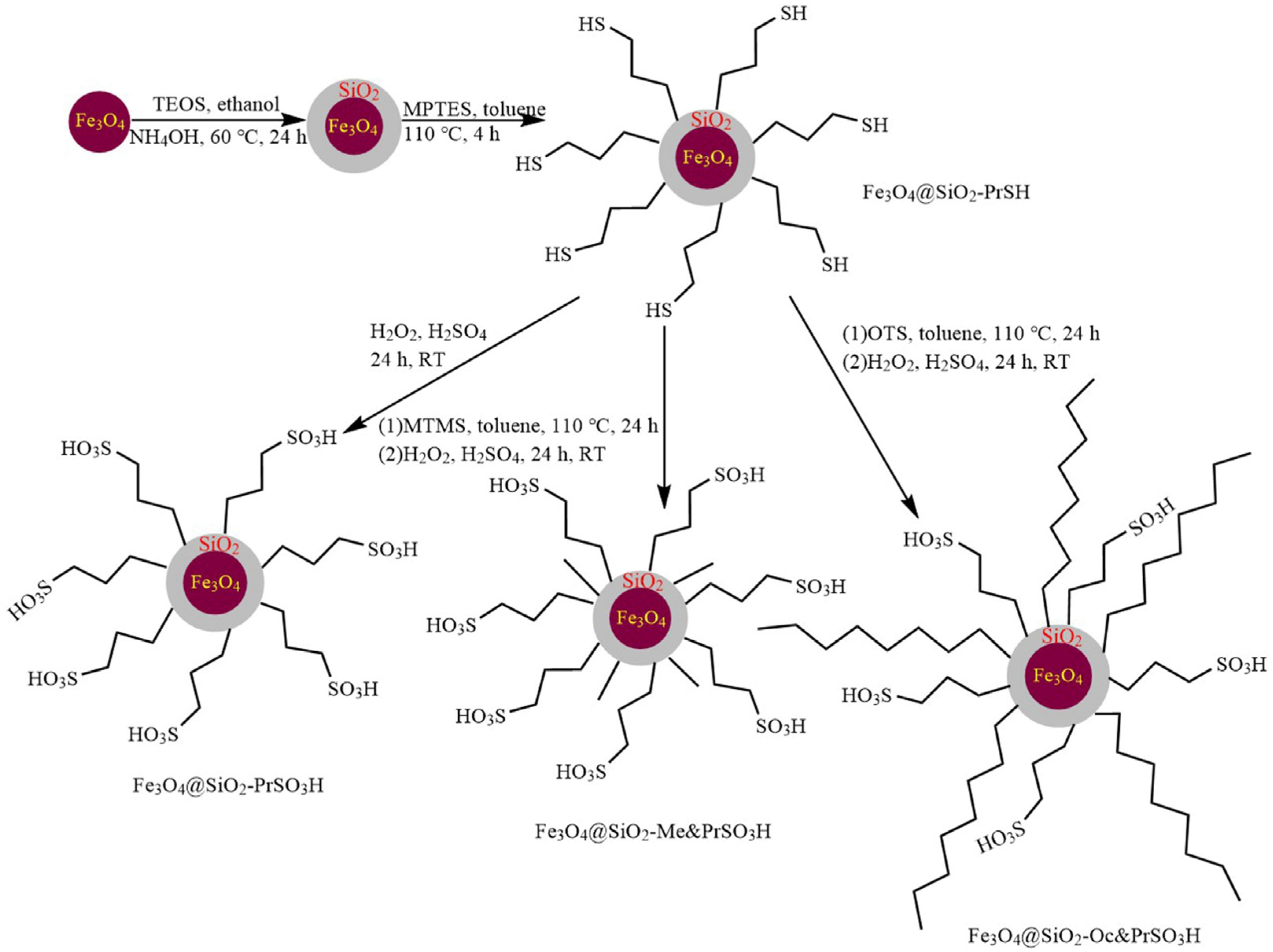


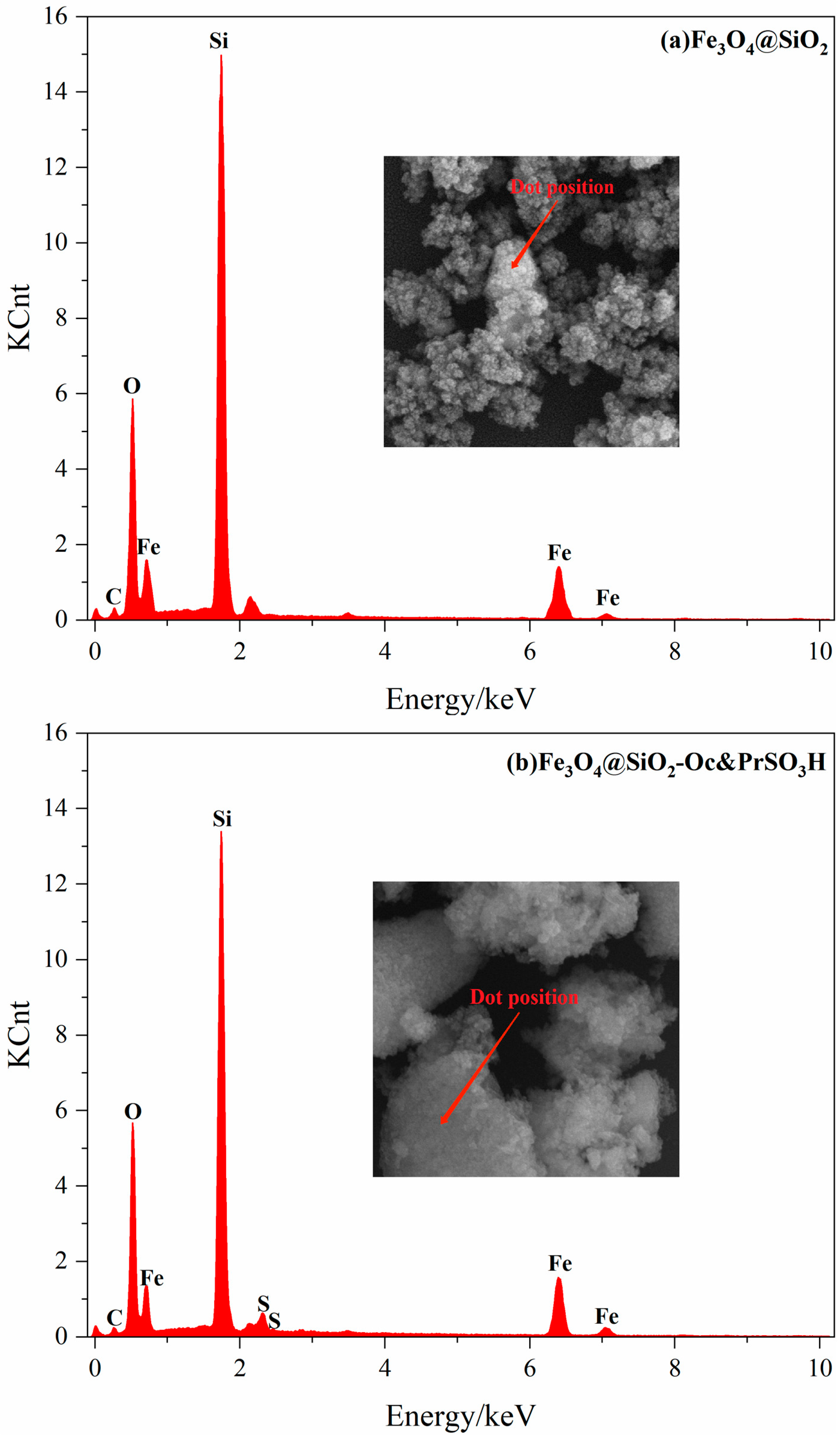
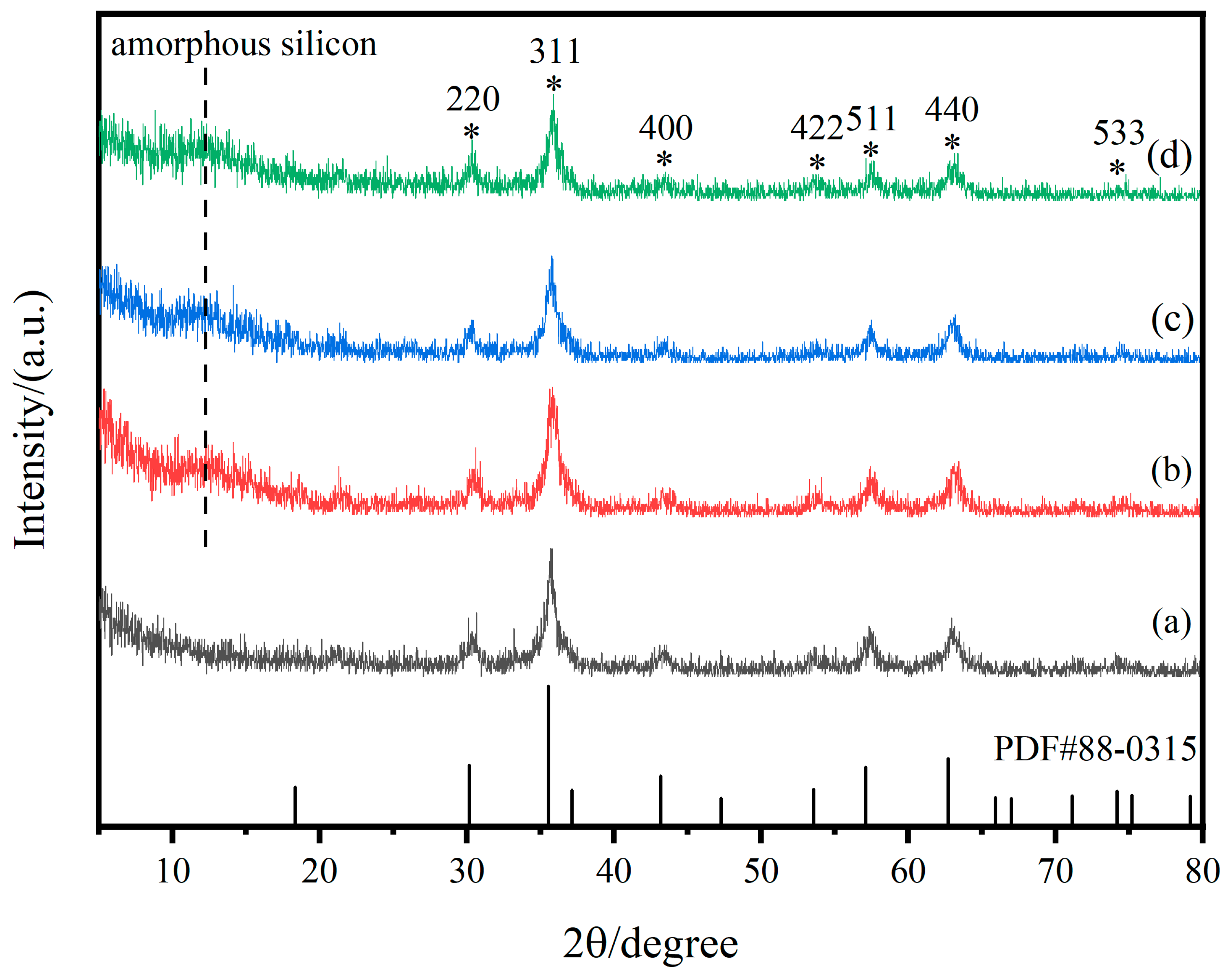
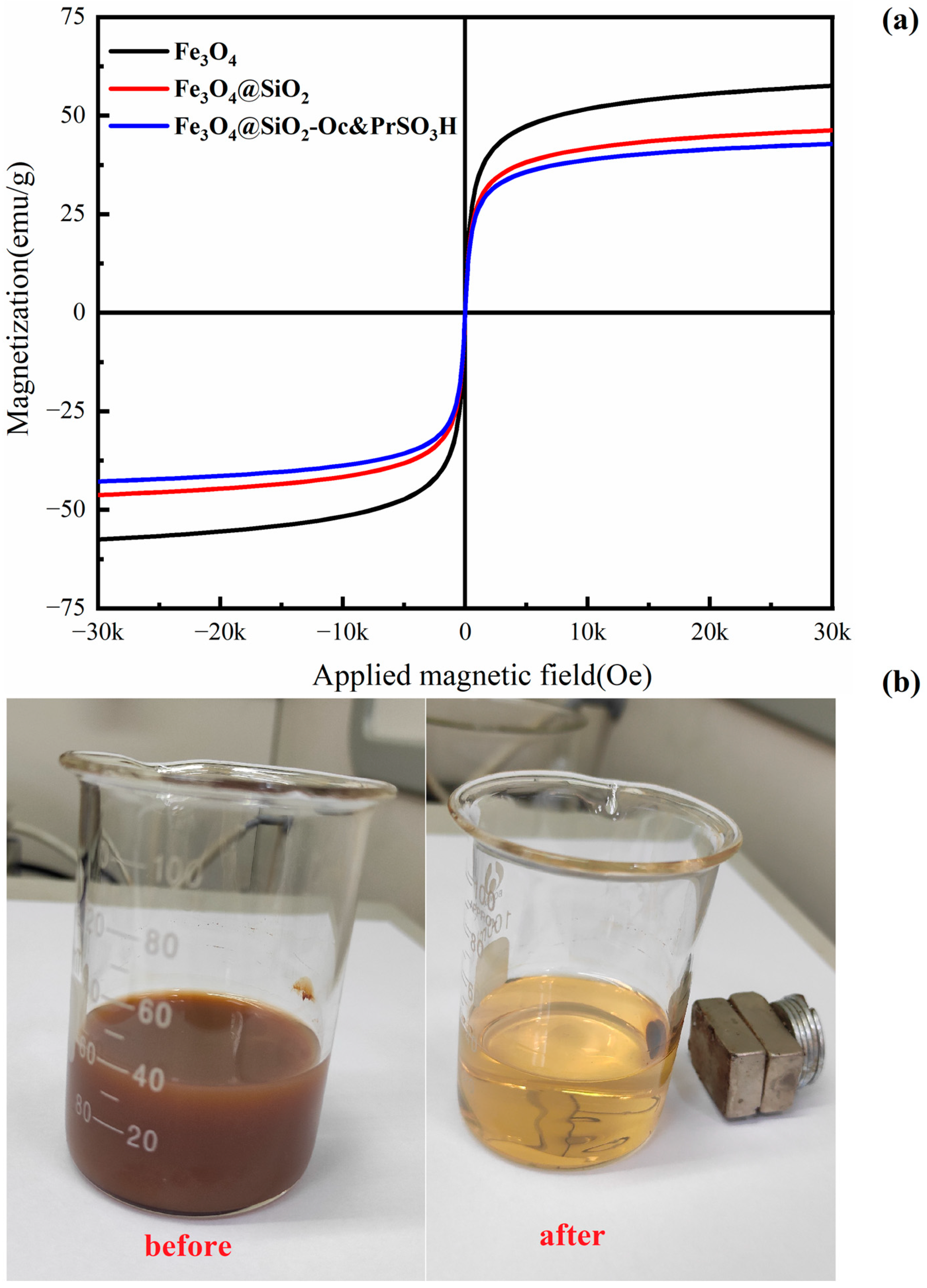


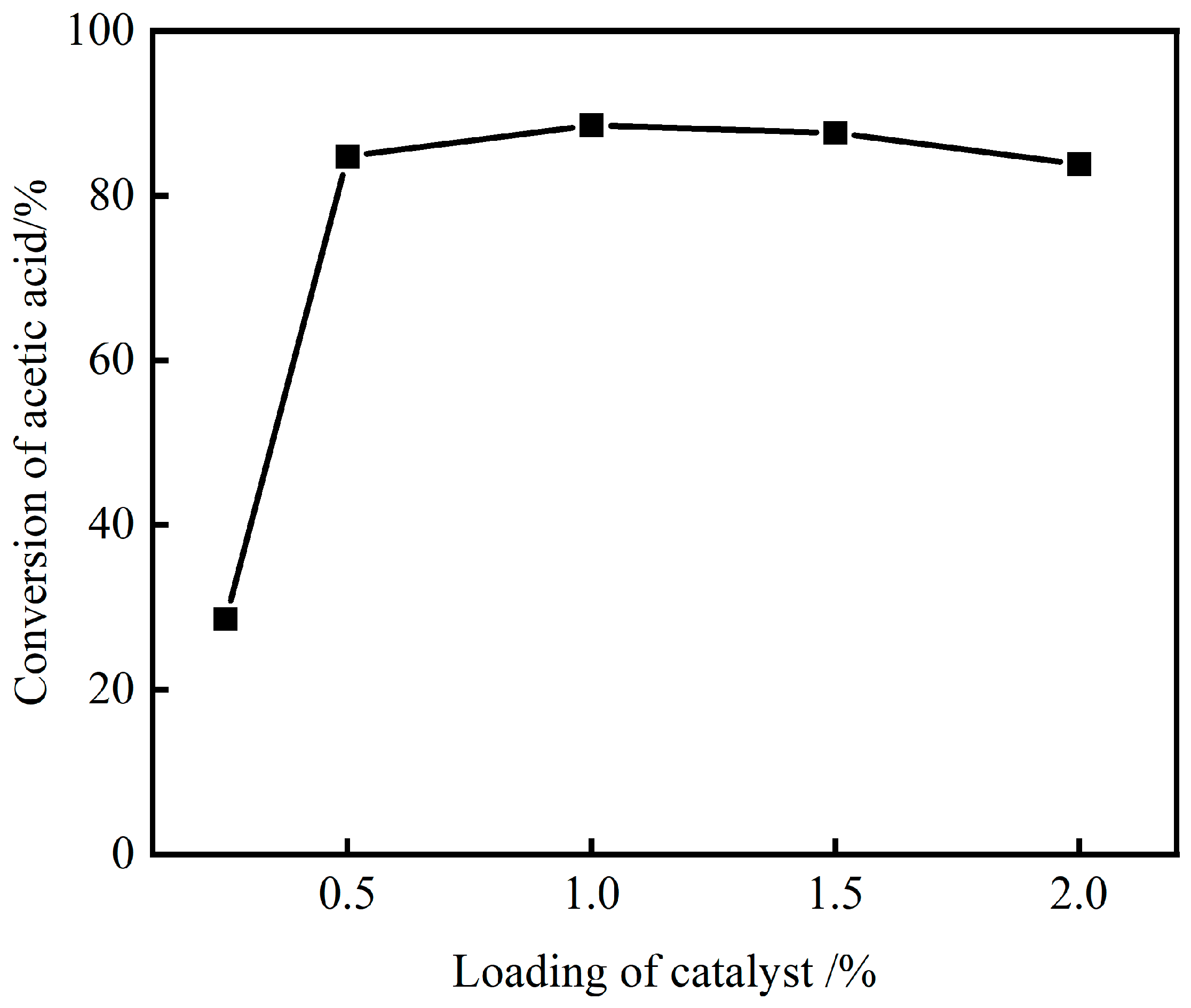


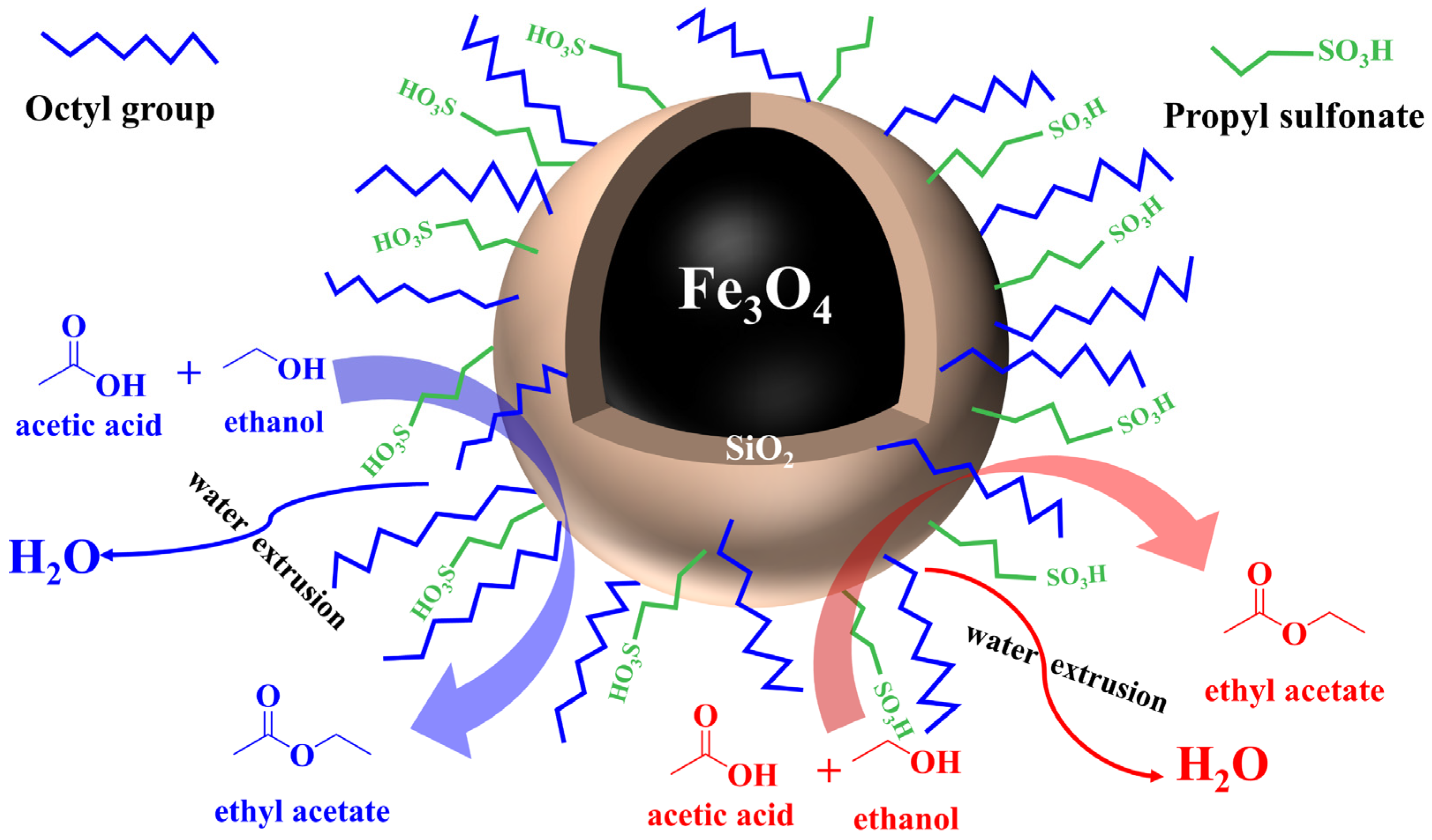


| Hydrophilic Solid Acid Catalysts | Hydrophobic Solid Acid Catalysts |
|---|---|
| Occupying catalyst active sites | Improving catalytic performance of catalysts |
| Leaching of active components | Improving stability of catalysts in polar medium |
| Leading to the collapse of the framework structure | Enhancing working life of catalysts |
| Suppressing the progress of the forward reaction | Expanding applications in acid-catalyzed reactions |
| Samples | Fe3O4 | Fe3O4@SiO2 | Fe3O4@SiO2-PrSO3H | Fe3O4@SiO2-Oc&PrSO3H | |
|---|---|---|---|---|---|
| Peak Types | |||||
| δ (Si-O-Si) [33] | - | 459 cm−1 | 459 cm−1 | 467 cm−1 | |
| υ (Fe-O) [33,42,43] | 585 cm−1 | 585 cm−1 | 585 cm−1 | 585 cm−1 | |
| υs (Si-O-Si) [37] | - | 800 cm−1 | 800 cm−1 | - | |
| υas (Si-O-Si) [38] | - | 1080 cm−1 | 1080 cm−1 | 1080 cm−1 | |
| υ (O=S=O) [44] | - | - | 1137 and 1220 cm−1 | 1137 and 1220 cm−1 | |
| υ (-OH of water) [45] | 1629 and 3422 cm−1 | 1629 and 3422 cm−1 | 1629 and 3422 cm−1 | 1629 and 3422 cm−1 | |
| υ (C-H) [38] | - | - | 2839 and 2913 cm−1 | 2840 and 2914 cm−1 | |
| υ (Si-OH) [37] | - | 3422 cm−1 | 3422 cm−1 | 3422 cm−1 | |
| Samples | Catalysts | Conversion (%) | TOF b (h−1) |
|---|---|---|---|
| 1 | Fe3O4@SiO2-PrSO3H | 85.71 | 5.098 |
| 2 | Fe3O4@SiO2-Me&PrSO3H | 87.62 | 5.212 |
| 3 | Fe3O4@SiO2-Oc&PrSO3H | 88.57 | 5.269 |
| Catalysts | Alcohol | T (°C) | t (h) | HOAc Conv. (%) | References | |
|---|---|---|---|---|---|---|
| Homogeneous | H2SO4 | Methanol | 60 | 2 | 91.7 | [52] |
| Hydrogen iodide | Methanol | 60 | 3 | ~53.13 | [53] | |
| [HSO3-BMIM][HSO4] | N-butanol | 75 | 3 | 75 | [54] | |
| Heterogeneous | Sc(OTf)3 | Benzyl alcohol | 20 | 48 | 98 | [55] |
| SAC-13 | Methanol | 60 | 11 | 75 | [56] | |
| Amberlyst 16 | Ethanol | 60 | 28 | 93.3 | [57] | |
| Zr–SBA-15(10)/[mim-ps]Cl–ZnCl2 | Benzyl alcohol | 100 | 5 | 93.6 | [58] | |
| Fe3O4@SiO2-Oc&PrSO3H | Ethanol | 80 | 3 | 88.57 | this work |
Publisher’s Note: MDPI stays neutral with regard to jurisdictional claims in published maps and institutional affiliations. |
© 2022 by the authors. Licensee MDPI, Basel, Switzerland. This article is an open access article distributed under the terms and conditions of the Creative Commons Attribution (CC BY) license (https://creativecommons.org/licenses/by/4.0/).
Share and Cite
Liu, J.; Shi, J.; Zhang, B.; Cheng, Z. Novel Magnetically-Recoverable Solid Acid Catalysts with a Hydrophobic Layer in Protecting the Active Sites from Water Poisoning. Processes 2022, 10, 1738. https://doi.org/10.3390/pr10091738
Liu J, Shi J, Zhang B, Cheng Z. Novel Magnetically-Recoverable Solid Acid Catalysts with a Hydrophobic Layer in Protecting the Active Sites from Water Poisoning. Processes. 2022; 10(9):1738. https://doi.org/10.3390/pr10091738
Chicago/Turabian StyleLiu, Jingjing, Juanli Shi, Bo Zhang, and Zhenmin Cheng. 2022. "Novel Magnetically-Recoverable Solid Acid Catalysts with a Hydrophobic Layer in Protecting the Active Sites from Water Poisoning" Processes 10, no. 9: 1738. https://doi.org/10.3390/pr10091738
APA StyleLiu, J., Shi, J., Zhang, B., & Cheng, Z. (2022). Novel Magnetically-Recoverable Solid Acid Catalysts with a Hydrophobic Layer in Protecting the Active Sites from Water Poisoning. Processes, 10(9), 1738. https://doi.org/10.3390/pr10091738








